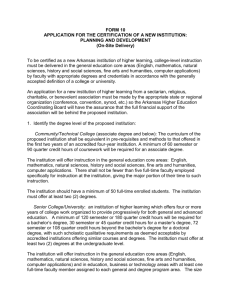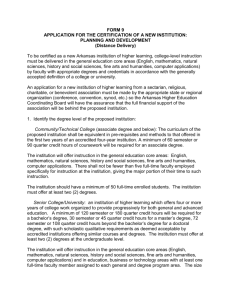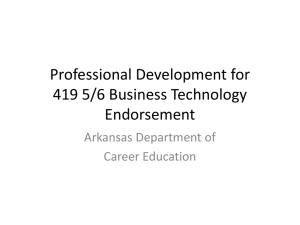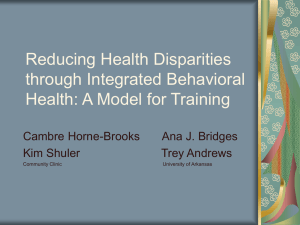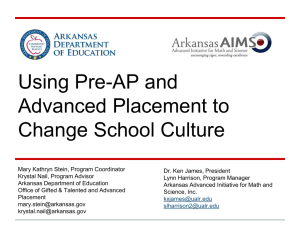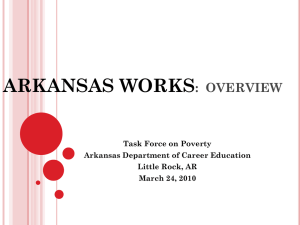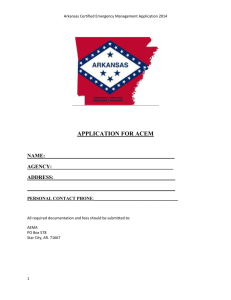Planning and Development for Academic Degrees
advertisement
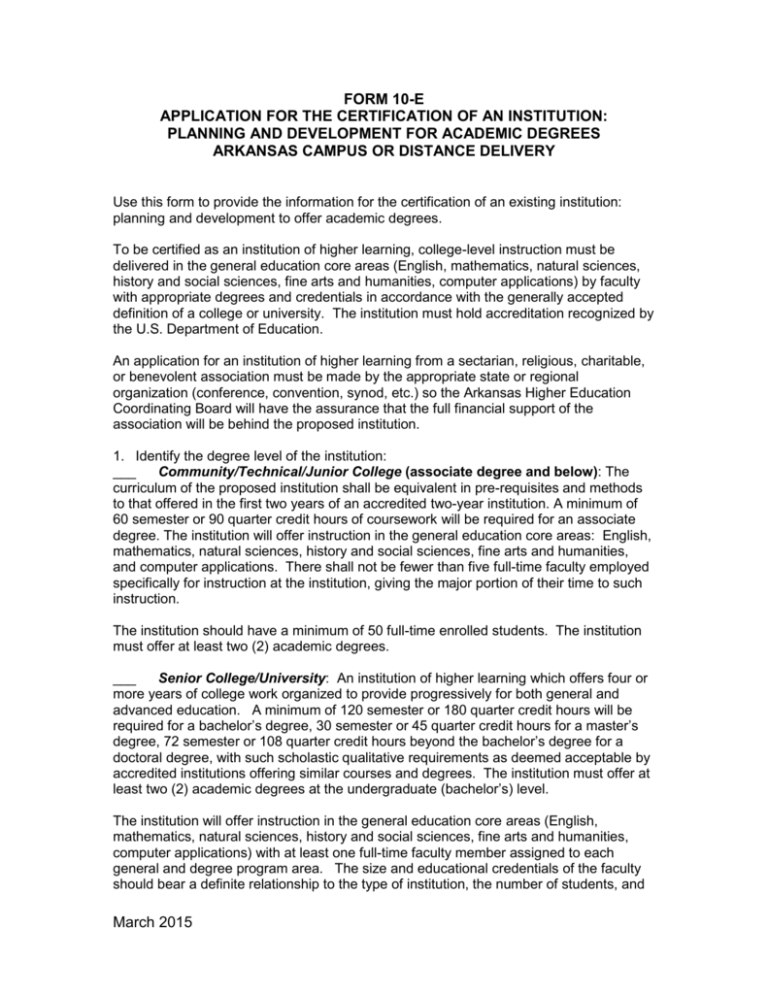
FORM 10-E APPLICATION FOR THE CERTIFICATION OF AN INSTITUTION: PLANNING AND DEVELOPMENT FOR ACADEMIC DEGREES ARKANSAS CAMPUS OR DISTANCE DELIVERY Use this form to provide the information for the certification of an existing institution: planning and development to offer academic degrees. To be certified as an institution of higher learning, college-level instruction must be delivered in the general education core areas (English, mathematics, natural sciences, history and social sciences, fine arts and humanities, computer applications) by faculty with appropriate degrees and credentials in accordance with the generally accepted definition of a college or university. The institution must hold accreditation recognized by the U.S. Department of Education. An application for an institution of higher learning from a sectarian, religious, charitable, or benevolent association must be made by the appropriate state or regional organization (conference, convention, synod, etc.) so the Arkansas Higher Education Coordinating Board will have the assurance that the full financial support of the association will be behind the proposed institution. 1. Identify the degree level of the institution: ___ Community/Technical/Junior College (associate degree and below): The curriculum of the proposed institution shall be equivalent in pre-requisites and methods to that offered in the first two years of an accredited two-year institution. A minimum of 60 semester or 90 quarter credit hours of coursework will be required for an associate degree. The institution will offer instruction in the general education core areas: English, mathematics, natural sciences, history and social sciences, fine arts and humanities, and computer applications. There shall not be fewer than five full-time faculty employed specifically for instruction at the institution, giving the major portion of their time to such instruction. The institution should have a minimum of 50 full-time enrolled students. The institution must offer at least two (2) academic degrees. ___ Senior College/University: An institution of higher learning which offers four or more years of college work organized to provide progressively for both general and advanced education. A minimum of 120 semester or 180 quarter credit hours will be required for a bachelor’s degree, 30 semester or 45 quarter credit hours for a master’s degree, 72 semester or 108 quarter credit hours beyond the bachelor’s degree for a doctoral degree, with such scholastic qualitative requirements as deemed acceptable by accredited institutions offering similar courses and degrees. The institution must offer at least two (2) academic degrees at the undergraduate (bachelor’s) level. The institution will offer instruction in the general education core areas (English, mathematics, natural sciences, history and social sciences, fine arts and humanities, computer applications) with at least one full-time faculty member assigned to each general and degree program area. The size and educational credentials of the faculty should bear a definite relationship to the type of institution, the number of students, and March 2015 the number of courses and degrees offered. With the expansion of the curriculum or an increase in the number of students, the number of full-time faculty should be increased correspondingly. The institution should have a minimum of 150 full-time enrolled students, with a proportionate number of these students continuing into the third- and fourth-year of study. 2. Name, physical address, and web address of institution. 3. Name, phone number, mailing address, and e-mail address of contact person. 4. Provide copy of Charter and/or Articles of Incorporation filed with the Arkansas Secretary of State. List members of Board of Trustees/Directors, and institutional chief executive officer. 5. Provide documentation of institutional accreditation or documentation of progress in attaining accreditation by an accrediting agency recognized by the United States Department of Education. 6. Name of proposed degree programs including curriculum outline with course names and course descriptions to be offered by institution. (Submit Form 5 and Form 14) 7. Proposed effective date of degree program implementation. 8. Indicate target student population to be served. 9. Provide general description of the institution including classification (i.e., private or forprofit), ownership (if applicable), and level of courses/degrees to be offered. 10. Indicate proposed campus site(s) of the institution. Describe physical facilities of institution. (Each campus site of the institution must be certified by AHECB.) If courses and/or degree programs will be offered by distance technology, provide information on technology infrastructure, course delivery methods, outsourcing contracts, data security, etc. 11. Provide the proposed timeline for the two-year planning and development phase including financial resources, program curricula, facilities, faculty/staff, and accreditation. 12. Provide documentation of financial stability appropriate for the institution’s stage of development, and a three-year budget for the planned course/degree programs including revenues, expenditures, and sources of funding. There must be guarantee of adequate and reasonably permanent financial support. Satisfactory evidence should be given that the proposed institution has the financial support necessary to provide adequate faculty, staff, buildings and instructional equipment necessary for the maintenance of the quality of work required of an institution of its type. March 2015 13. In an effort to protect Arkansas students from financial hardship and loss due to the unexpected closure of an institution certified by the Arkansas Higher Education Coordinating Board (AHECB), non-public and out-of-state, postsecondary institutions certified to offer college-level course/degree programs in Arkansas will maintain a surety bond during operations in Arkansas unless the institution maintains a minimum financial responsibility composite score of 1.5 determined by the U.S. Department of Education. AHECB certified institutions required to maintain a bond should make the bond equal to the gross tuition collected from Arkansas students during the previous fiscal year, with a minimum bond amount of $5,000. For AHECB certified institutions not yet collecting tuition from Arkansas residents, the minimum bond amount is $5,000. An admitted bond company authorized and approved to do business in Arkansas must issue the institution’s bond. A list of admitted bond companies can be obtained from the Arkansas Insurance Commission. (Submit Form 15) 14. Provide documentation of external advisory group meetings. 15. Provide proposed full-time administrator and faculty positions and educational qualifications. (Submit Form 12 and Form 13) 16. Describe Student Support Services (academic advising, registration, orientation, financial aid, tuition refund policy, tutoring, career counseling and placement) 17. Entrance Requirements, Testing, and Placement Indicate the process used to determine that students possess the aptitude and background to benefit from the course or degree program List standardized assessments used for placement in college-level courses Indicate the use of the testing scores for placement List provisions for remedial assistance 18. Faculty Development and Assignments Provide the process for hiring and firing faculty and staff including requirements for new faculty applicants, orientations, and policies on continuing faculty development. Include what means are used to monitor the faculty in the following areas: Teaching course content Accessibility to students Maintaining “office” hours What contingency is made for classes if the faculty member is ill or leaves the employment of the institution? 19. Financial Aid Indicate the process you have in place to assist students in receiving financial aid. Indicate what steps the institution takes if the student drops classes and owes a private lender, Pell Grant, or the institution. Is a collection agency used? Who oversees the process? March 2015 20. Program Delivery Indicate the process and responsible party for determining which degree programs are offered at the Arkansas campus How is the decision made not to offer a course? Who decides? What happens if a student needs a course to graduate? Will there ever times that a publicized degree is not offered? What options will be given to the student? Do you publicize the cancellation? Do you have a maximum student enrollment to offer a class? Indicate what guarantee is in place that the student will be able to enroll in a timely manner into the next degree or course. Who writes the course materials and exams? What role does the instructor have in course development? Who develops the syllabus for each course? How is the course sequence and degree plan developed? 21. Assessment of Outcomes Provide information on student evaluations and their use in improvement to the programs. Provide copies of student and faculty evaluations and assessment documents. 22. Consumer Disclosure Submit Form 16 signed by the chief academic officer. Include copies of Transfer policy that will be included in catalog and copies of other documents as indicated on Form16. 23. Student Grievance Procedures Include a copy of institution’s procedures. 24. Provide additional information requested by the Arkansas Department of Higher Education. March 2015
